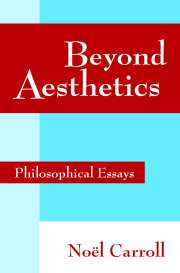Book contents
- Frontmatter
- Contents
- Foreword by Peter Kivy
- Introduction
- PART I BEYOND AESTHETICS
- PART II ART, HISTORY, AND NARRATIVE
- PART III INTERPRETATION AND INTENTION
- Art, Intention, and Conversation
- Anglo-American Aesthetics and Contemporary Criticism: Intention and the Hermeneutics of Suspicion
- The Intentional Fallacy: Defending Myself
- Interpretation and Intention: The Debate between Hypothetical and Actual Intentionalism
- PART IV ART, EMOTION, AND MORTALITY
- PART V ALTERNATIVE TOPICS
- Notes
- Index
Interpretation and Intention: The Debate between Hypothetical and Actual Intentionalism
Published online by Cambridge University Press: 19 January 2010
- Frontmatter
- Contents
- Foreword by Peter Kivy
- Introduction
- PART I BEYOND AESTHETICS
- PART II ART, HISTORY, AND NARRATIVE
- PART III INTERPRETATION AND INTENTION
- Art, Intention, and Conversation
- Anglo-American Aesthetics and Contemporary Criticism: Intention and the Hermeneutics of Suspicion
- The Intentional Fallacy: Defending Myself
- Interpretation and Intention: The Debate between Hypothetical and Actual Intentionalism
- PART IV ART, EMOTION, AND MORTALITY
- PART V ALTERNATIVE TOPICS
- Notes
- Index
Summary
Regarded for decades as a fallacy, intentionalist interpretation is beginning to attract a following among philosophers of art. Broadly speaking, intentionalism is the doctrine that the actual intentions of artists are relevant to the interpretation of the artworks they create. For intentionalists, interpretation is a matter of explaining why artworks have the features, including meanings, that they possess. Since artworks possess these features as a result of the actions of artists, it seems natural to explain them, as we explain the results of actions in general, with an eye to the intentions of the pertinent agents, who are, in this case, artists.
Actual intentionalism holds to the conviction that interpretation with respect to artworks is on a continuum with interpretation of intentional action in daily life. Just as in ordinary affairs we interpret with the goal of identifying the actual intentions of the words and deeds of others, so with respect to art the actual intentions of artists are relevant to our interpretations of their productions.
Actual intentionalism, however, comes in different forms. The most extreme form maintains that the meaning of an artwork is fully determined by the actual intentions of the artist (or artists) who created it. It is this extreme form of actual intentionalism that one suspects has encouraged the view that actual intentionalism is a fallacy. For this view leads to the unpalatable conclusion that the meaning of an artwork is whatever the author intends it to mean, irrespective, if we are talking about literary texts, of the word-sequence meaning of the text (the meaning of the text derivable solely by consulting dictionaries, the rules of grammar, and the conventions of literature).
- Type
- Chapter
- Information
- Beyond AestheticsPhilosophical Essays, pp. 197 - 214Publisher: Cambridge University PressPrint publication year: 2001
- 5
- Cited by



